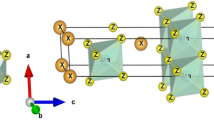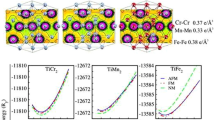Abstract
Electric field gradient (EFG) measurements for Fe2+ in the cis- and trans-sites of a large single crystal of trioctahedral biotite of the lM polytype are described. Attempts to apply thickness and polarisation corrections are outlined. The measured EFG's are distinctly rhombic: η = 0.28 and 0.42 respectively for the cis- and transsites and the EFG principal directions lie approximately along the crystallographic axes. For the cis-site V yŷ lies close to the normal to the basal plane while for the transsite \(V_{\hat z\hat z}\) lies close to this direction.
Similar content being viewed by others
References
Aldridge LP, Finch J, Gainsford AR, Tennant WC, Childs CW (1987) Electric-field gradient in muscovites. Am Mineral 72:528–536
Bailey SW (1984) Classification and structures of the micas. In: Bailey SW (ed) Reviews in mineralogy vol. 13, Mineralogical Society of America, Michigan, USA
Ballet O, Amthauer G (1986) Room temperature Mössbauer study of the EFG tensor at the iron sites in sheet silicates. J Phys C: Solid State Phys 19:7099–7112
Ballet O, Coey JMD (1982) Magnetic properties of sheet silicates; 2∶1 layer minerals. Phys Chem Minerals 8:218–229
Bancroft GM (1973) Mössbauer spectroscopy — an introduction for inorganic chemists and geochemists. McGraw Hill, New York
Bancroft GM, Brown JR (1975) A Mössbauer study of coexisting hornblendes and biotites: Quantitative Fe3+/Fe2+ ratios. Am Mineral 60:265–272
Chandra R, Lokanathan S (1977) Electric field gradient in biotite mica. Phys Status Solidi b 83:273–280
Cranshaw TE (1974) The deduction of the best values of the parameters from Mössbauer spectra. J Phys E 7:122–124
Dyar MD (1990) Mössbauer spectra of biotite from metapelites. Am Mineral 75:656–666
Dyar MD (1984) Precision and interlaboratory reproducibility of measurements of the Mössbauer effect in minerals. Am Mineral 69:1127–1144
Dyar MD, Burns RG (1986) Mössbauer spectral study of ferruginous one-layer trioctahedral micas. Am Mineral 71:955–965
Finch J, Gainsford AR, Tennant WC (1982) Polarized optical absorption and 57Fe Mössbauer study of pegamatitic muscovite. Am Mineral 67:59–68
Gibb TC (1978) The orientation of the electric-field-gradient tensor from single crystal Mössbauer measurements. J Chem Soc., Dalton Trans (7): 743–752
Grant RW, Housley RM, Gonser U (1969) Nuclear electric field gradient and mean square displacement of the iron sites in sodium nitroprusside. Phys Rev 178:523–530
Housley RM, Erickson NE, Dash JG (1964) Measurement of recoilfree fractions in studies of the Mössbauer effect. Nucl Instrum Methods 27:29–37
Housley RM, Grant RW, Gonser O (1969) Coherence and polarisation effects in Mössbauer absorption by single crystals. Phys Rev 178:514–522
Margulies S, Ehrman JR (1961) Transmission and line broadening of resonance radiation incident on a resonance absorber. Nucl Instrum Methods 12:131–137
Müller EW (1980) Mössbauer spectra fitting program for universal theories. Institut für Anorganische Chemie und Analytische Chemie, Johannes Gutenberg Universität, Mainz
Spiering H (1984) The electric field gradient and the quadrupole interaction. In: Long GJ (ed) Mössbauer spectroscopy applied to inorganic chemistry, vol. 1. Plenum, New York, pp 77–170
Townsend MG, Longworth G (1985) Sign of the magnetic coupling of Fe2+ and Fe3+ in biotite. Phys Chem Minerals 12:141–144
Ure MCD, Flinn PA (1971) A technique for the removal of the “blackness” distortion of Mössbauer spectra. In: Gruverman IJ (ed) Mössbauer effect methodology, vol. 7. Plenum Press, New York, pp 245–262
Zimmermann R (1975) A method for evaluation of single crystal 57Fe Mössbauer spectra (FeCl2·4H2O). Nucl Instrum Methods 128:537–543
Zimmermann R (1983) The intensity tensor formulation for dipole transitions (e.g. 57Fe) and its application to the determination of EFG tensor. In: Thosar BV, Srivastava JK, Iyengar PK, Bhargava SC (eds) Advances in Mössbauer spectroscopy. Elsevier, The Netherlands, pp 273–315
Author information
Authors and Affiliations
Rights and permissions
About this article
Cite this article
Aldridge, L.P., Finch, J., Gainsford, G.J. et al. Single crystal Mössbauer studies of 1M biotite. Phys Chem Minerals 17, 583–590 (1991). https://doi.org/10.1007/BF00203837
Received:
Issue Date:
DOI: https://doi.org/10.1007/BF00203837




